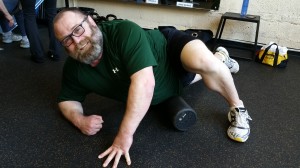National Foam Rolling Day
May 11th is National Foam Rolling Day! Trigger Point submitted the application for a national holiday and it has been one since 2015. Though the foam roller was patented in 1920, foam rolling has recently gained momentum.
What is foam rolling?
Self-myofascial release is a self-massage to release muscle tightness, or trigger points. Trigger points, also known as “knots,” exist in the muscles and occur when our bodies exceed their ability to recover from intense workouts, poor posture, stress, etc.
This type of massage helps muscles recover and return to normal functioning and allows normal blood flow to restore tissue. Through foam rolling, your muscles will be healthy, elastic and ready to perform when needed! On the contrary, not taking care of your muscles can lead to loss of flexibility, adhesions and painful movements. These deep compressions can be done with lacrosse balls, tennis balls or even your own hands, but one of the best methods is using the foam roller!
Foam Rolling is like getting a deep tissue massage, only, you have the control. Ultimately, the process will enhance performance by allowing pain-free movements and proper movement patterns. One cannot rely only on stretching.
“Imagine a bungee cord with a knot tied into it and then envision stretching the cord. This creates tension, stretching the
unknotted portion of the muscle and the attachment points. The knot, however, has remained unaltered,” (What is a Foam Roller, Breakingmuscle.com).
What does foam rolling feel like?
Generally, foam rolling is uncomfortable. It can be slightly painful but not unbearable. If it becomes unbearable, stop and consult a professional. The discomfort and pain is similar to that of stretching. For some, foam rolling is a good discomfort. You should feel a difference immediately after and as time passes. The longer you have foam rolling incorporated into your workout routine the more you will notice the benefits of it.
There are a lot of types of foam rollers such as high density, Premium EVA, Closed Cell, Rumble Roller, The Grid 2.0, The Grid, and more, that we won’t go into detail here. Some are smooth and others, like the Rumble, are covered in bumps that provide an extra massage. At Rock Creek Sports Club we have many different foam rollers, of varying sizes and firmness.
“I never knew about foam rolling before coming to this gym. It helped tremendously early on. Foam rolling saved my life!” says Joff Pincher, one of our members, and a recent member of the quarter.
How to foam roll…
Apply moderate pressure, usually your body weight. Roll slowly, no more than an inch a second. When you find knots, pause and relax for 5-30 seconds. You can even rest on an area for as long as 90 seconds (How and When to Use Foam Rollers, McCall). Gradually, you will feel the discomfort, tightness and pain lessen. If an area is too painful, you can help ease into rolling it out by loosening areas around it first.
Do not roll on joints or bones! Also, be careful with your lower back.
What and where you chose to foam roll depends on your fitness needs.
You may target specific areas associated with your workouts. Or, you can focus on trigger points and knots found through self-exploration. Some great places to foam roll are your calves, quads and your buttocks. 
You can foam roll your calves in two ways. You can have one leg on top of the foam roller and roll it from under the knee to the ankle. Or you can stack both legs and put the pressure on one, this will add more pressure overall.
For your IT Band, lie on your side with the roller at your hip and move it along your outer thigh.
Lastly, for your butt, sit on the roller with one foot on the opposite knee, lean into one buttock and roll back and forth. This is especially effective with a foam ball.
When to foam roll…
Foam rolling can be used after a workout to promote recovery and reduce soreness or before a workout as a warm up. As a warm up it helps reduce tension while also raising temperatures in the muscles without causing fatigue. However, when used as a warm up, foam rolling should be brief. Too much pressure can change a muscle’s ability to produce force (How and When to Use Foam Rollers, McCall). For others, foam rolling is a regular part of the daily routine. A foam roller is then used at home at the beginning or end of the day, or both.
Final notes; you may be sore the next day but not excessively. And as with any workout routine, it works best if you are supplementing it with lots of water, sleep and healthy eating!

